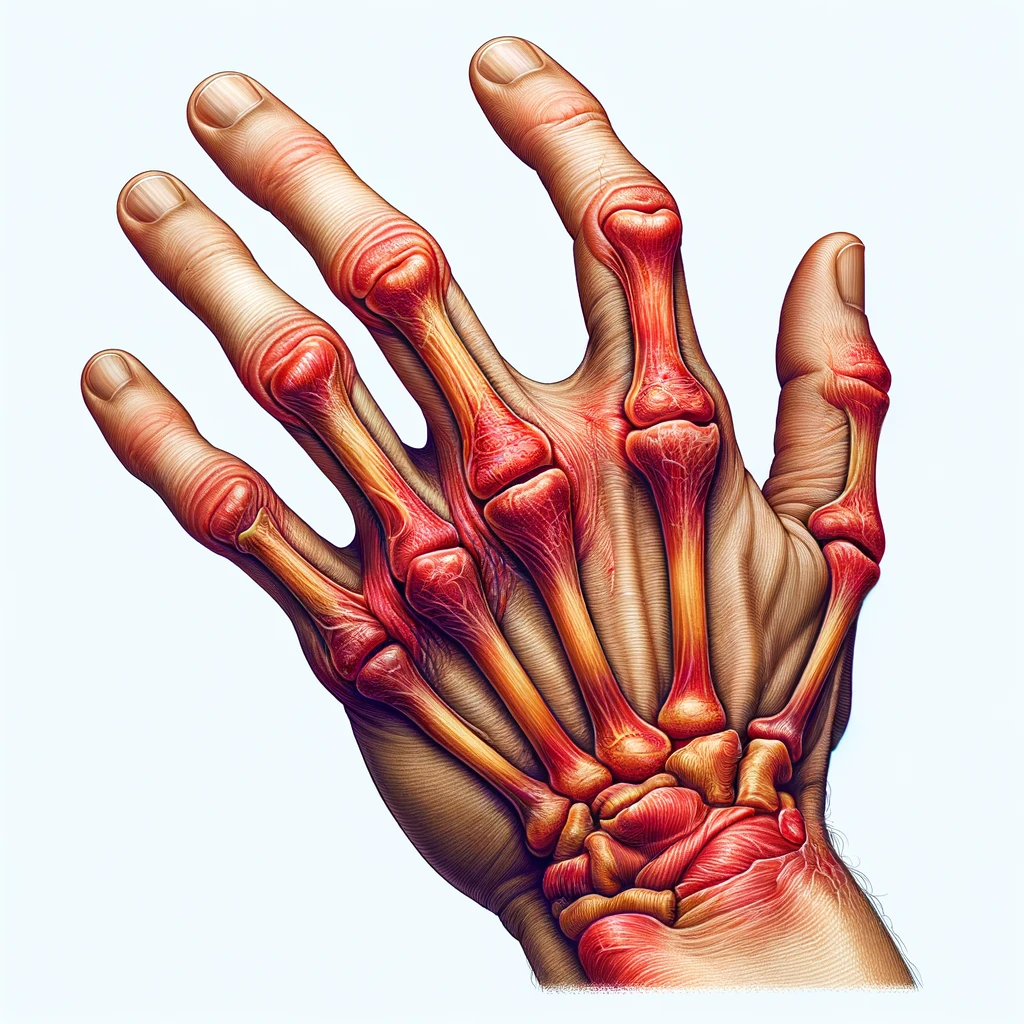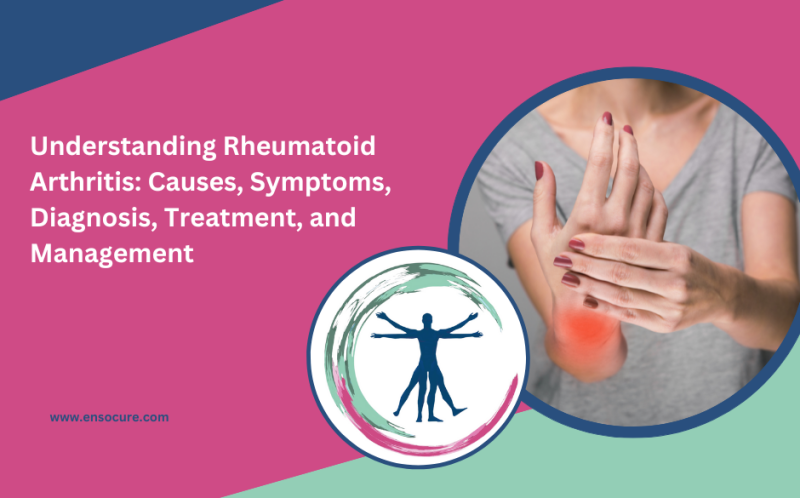Rheumatoid arthritis (RA) is a chronic autoimmune disorder that primarily affects the joints, causing inflammation, pain, and deformities. This debilitating condition usually attacks the joints, knees, hands, and ankles, but can sometimes affect the eyes, circulatory system, heart, and lungs. RA can significantly impact a person’s quality of life and daily activities. For reasons yet to be understood fully, RA is more prevalent in women than men, typically arising in middle age. Genetic factors, such as having a family member with RA, may increase the likelihood of developing the condition.

In India, the estimation of RA 0.7%3 is higher than the global prevalence of 0.46% with statistics in 2021 finding almost 1.3 crore people suffering from RA in India. According to a nationwide study, the three cities that topped the prevalence of RA in India were Delhi, Mumbai and Bengaluru.
What is Rheumatoid Arthritis

Rheumatoid arthritis is a systemic autoimmune disease that primarily targets the synovium, the lining of the membranes that surround the joints. Unlike osteoarthritis, which results from wear and tear on the joints, RA is driven by an overactive immune system attacking healthy tissues. The synovium becomes inflamed, leading to the production of excess joint fluid, swelling, and the formation of pannus – a thickened layer of tissue that can erode the cartilage and bone within the joint. Pannus once formed is irreversible and currently there is no medication that can cure pannus except for effective RA management to reduce symptoms and improve quality of life.
Progression of Rheumatoid Arthritis
RA often progresses in a symmetrical fashion, affecting the same joints on both sides of the body. The disease typically begins gradually, with mild joint pain and stiffness, and may progress to more severe symptoms over time. Once inflammed, the synovium thickens causing tenderness, swelling, redness, and pain, moving the joints becomes difficult. The most affected areas in RA are the ankles, knees, hands, fingers, shoulders, wrists, and elbows. Without proper management, persistent inflammation can lead to joint deformities and destruction, causing a significant decline in joint function.
The Underlying Causes of RA
The exact causes of RA are not fully understood. Still, it is believed to involve genetic predisposition triggered by environmental factors such as viruses, bacteria, physical or emotional stress, or other external elements. Medical research is yet to find out how RA develops, but there is a belief that genes triggered by environmental factors like bacteria, virus and stress could play a role. Moreover, it is more prevalent in women than men, typically arising in middle age. Genetic factors, such as having a family member with RA, may increase the likelihood of developing the condition. Individuals with a family history of autoimmune disorders may be at a higher risk of developing RA.
Risk Factors for Rheumatoid Arthritis
- Genetics: Individuals with a family history of RA are more susceptible to the disease.
- Gender: Women are more likely to develop RA than men.
- Age: Although RA can affect people of all ages, it commonly begins between the ages of 40 and 60.
- Smoking: Smoking is a significant environmental risk factor for RA.
- Obesity: Excess body weight may contribute to the severity of RA symptoms.
Symptoms
Early RA stages may not exhibit visible redness or swelling in the joints, but tenderness and pain are common. Critical indicators of RA include:
• Multiple joints are affected.
• The same joints are affected on both sides of the body.
• Morning stiffness persists for at least 30 minutes.
• Persistent joint pain, tenderness, swelling, or stiffness lasting six weeks or more.
• The initial impact is often seen in smaller joints (e.g., wrists, specific hand, and foot joints).
Fatigue and possibly a low-grade fever are also common in RA, with symptoms fluctuating over time. Periods of heightened symptoms, known as flares, can last days or months.
Health Impacts of Rheumatoid Arthritis
Rheumatoid arthritis (RA) affects various body parts beyond the joints:
Eyes: Symptoms include dryness, redness, light sensitivity, inflammation, pain, and vision problems.
Mouth: Issues involve dryness, irritation, gum inflammation, or infection.
Skin: Development of rheumatoid nodules, which are small lumps under the skin over bony areas.
Lungs: Inflammation and scarring can lead to breathlessness and lung disease.
Blood: A reduction in red blood cell count.
Blood Vessels: Inflammation can cause damage to nerves, skin, and other organs.
Heart: Inflammation can harm the heart muscle and surrounding areas.
Weight Gain: Painful joints often result in reduced physical activity, contributing to weight gain. This can increase the risk of high cholesterol, diabetes, heart disease, and high blood pressure in individuals with RA.
Joint Deformities: If left untreated, RA can lead to joint deformities and reduced range of motion.
Diagnosis of Rheumatoid Arthritis
There is no single test that definitively diagnoses RA. Rather, the diagnosis is based on a combination of clinical findings, laboratory results, and imaging studies. Early diagnosis and treatment are crucial in managing RA and preventing joint damage. If you suspect you may have RA, it’s essential to consult with a rheumatologist for a comprehensive evaluation.
- Medical History: Your doctor will ask about your symptoms, their duration, and any factors that may trigger them.
- Physical Examination: The doctor will examine your joints for swelling, warmth, tenderness, joint deformities, or limitations in movement.
- Blood Tests/ Rheumatoid Factor (RF): Almost 80% of people with RA will have this RF factor antibody present in their blood; however, RF can also be present in people without RA.
- Anti-Cyclic Citrullinated Peptide (anti-CCP) Antibodies: 60% to 70% of people will have CCP antibodies in their blood being more specific to RA. However, they can also be elevated in other rheumatologic conditions such as systemic lupus erythematosus.
- C-reactive Protein (CRP) and Erythrocyte Sedimentation Rate (ESR): These are inflammatory markers whose elevated levels along with symptoms and clues could suggest RA.
- X-rays: X-rays can help in detecting joint damage, such as erosion or narrowing of joint spaces.
- Magnetic Resonance Imaging (MRI): This imaging technique provides detailed images of soft tissues and can help assess joint damage and inflammation. An MRI can detect scars and lesions, but if they do not show up, it means the disease is still in early stages.
- Ultrasound: Ultrasound can visualize joint inflammation and detect synovitis (inflammation of the lining of the joint).
Treatment of Rheumatoid Arthritis
While there is no cure for rheumatoid arthritis, a variety of treatment options are available to manage symptoms, slow disease progression, and improve overall quality of life.
Medications: Nonsteroidal anti-inflammatory drugs (NSAIDs), disease-modifying antirheumatic drugs (DMARDs), and biologics are commonly prescribed to alleviate pain, reduce inflammation, and modulate the immune system.
Physical therapy: Engaging in tailored exercises under the guidance of a physical therapist can help maintain joint function, improve flexibility, and alleviate stiffness.
Hot and cold treatments. Heating pads, warm compress or warm baths can help soothe stiff joints and fatigued muscles. Cold packs are good for acute pain and swollen joints to numb the areas and reduce inflammation.
Lifestyle modifications: Making lifestyle changes, such as maintaining a healthy weight, quitting smoking, and managing stress, can positively impact RA symptoms.
Physical activity and rest: Try to make movement a daily activity and balance it with rest. Physical activity in RA is important, but rest is also important to reduce inflammation and flare ups.
Topical products: There are topical creams available in India that can reduce joint and muscle pain. ..
Stress reduction therapies. Stress management is important in treating RA to help you relax and get relief from pain. Try meditation, yoga, or deep breathing visualizing things that make you happy. A massage can also help relax your muscles and relieve pain. Some research has found how acupuncture and acupressure can also help manage rheumatoid arthritis.
Supplements: Some research has found how curcumin/turmeric and omega-3 fish oil supplements can help gain relief from RA pain and stiffness. Always consult your doctor before taking any supplement.
Surgery: In severe cases where joint damage is extensive, surgical interventions like joint replacement surgery may be considered to restore function and alleviate pain.
Patient education and support: Understanding the nature of RA and learning self-management strategies are crucial aspects of living with the condition. Support groups and educational resources can provide valuable insights and emotional support.

Rheumatoid arthritis is a complex autoimmune disorder that requires a comprehensive approach to management. Understanding the disease, its causes, and risk factors, you can easily manage it to gain relief from pain and live a better quality of life. Physiotherapy is an important part of RA management. If you’re looking for a good physiotherapy clinic in Bengaluru, then Ensocure Integrated Medicine can help provide physio services including home health care and medical assistance for elderly afflicted with rheumatoid arthritis.

